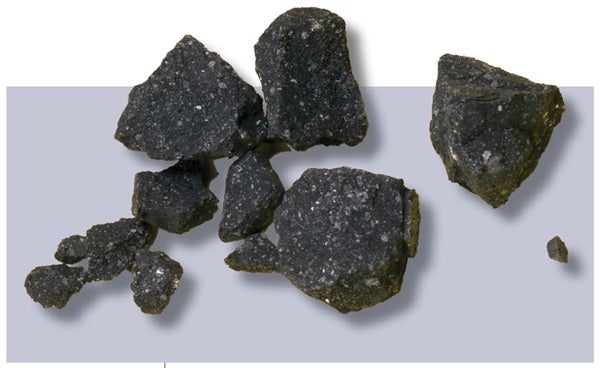Happily, atmospheric drag robs all meteoroids less than 8 tons of practically every bit of their cosmic velocity. By the time they’ve descended to where jetliners cruise, they will be falling solely from Earth’s gravity and reach a terminal velocity between 200 and 400 mph (90–180 m/s). That’s the speed at which meteorites hit Earth’s surface.
Serious danger comes from meteoroids weighing more than 10 tons because these retain a portion of their original space velocity, and damage-producing kinetic energy depends far more on an object’s speed than its mass. According to the American Meteor Society (AMS), “a 10-ton meteoroid entering the Earth’s atmosphere perpendicular to the surface will retain about 6 percent of its cosmic velocity on arrival at the surface.” If it started at 90,000 mph (40,000 m/s), it would strike the ground at 5,400 mph (2,400 m/s). Yikes!
It could be worse — much worse. The AMS also says that “a meteoroid of 1,000 tons would retain 70 percent of its cosmic velocity, and bodies of over 100,000 tons will cut through the atmosphere as if it were not even there.”
Fortunately, larger meteoroids often break up around 10 miles (16 kilometers) above the surface, especially if they are stony. The fragments then abruptly slow down thanks to their reduced momentum. So, smaller, slower bodies are what commonly rain down.
Is there any way to assess their physical hazard to us? The surprising answer is yes, thanks to the strange human proclivity for celebratory gunfire. That’s when people fire guns straight up, usually during occasions like New Year’s Eve or the Fourth of July.
You’d think the chance of injury would be minuscule. Not so. In Puerto Rico alone, two people are killed and 25 injured each New Year’s Eve because of celebratory bullets that come down on their heads. The density and mass of these objects can be similar to asteroid fragments that reach us as meteorites, so I did some research.
Bullets fired into the air during celebrations can return at a speed of up to 400 mph (180 m/s), which well exceeds the 157 mph (70 m/s) at which a bullet can penetrate the skin to damage organs. In Los Angeles between 1985 and 1992, doctors at Martin Luther King Jr./Drew Medical Center treated 118 people for random falling-bullet injuries, and 38 of them died. A 1994 study in the Journal of Trauma: Injury, Infection, and Critical Care showed that of those 118 patients, 77 percent were hit in the head, and these had a mortality rate of 32 percent.
Heft matters, too. In experiments conducted before World War II, .30-caliber rifle bullets fired straight up reached an altitude of 10,000 feet (3,050 m) and ultimately descended at 300–600 feet per second (90–180 m/s), which can easily fracture bone and cause intracranial penetration. Lighter bullets, like those fired from a 9mm handgun, return to Earth at lower speeds between 150 and 250 feet per second (45–75 m/s).
This suggests iron meteorites like octahedrites are more than twice as hazardous as the lower-density carbonaceous chondrites. And with meteorites and bullets alike, location matters. Falling objects slow dramatically in thicker air, whose resistance decreases with altitude. So, meteorites and bullets are more hazardous in Tibet than in, say, Brooklyn.
Are you worried now about our upcoming meteor showers? Don’t be. Their “shooting stars” are skimpy ices that cannot survive their trip through the atmosphere. They can’t hit you, ever. As for protecting yourself from celebratory fire, which although illegal in the United States can be a real concern, consider that if some friend ever fires straight up into the air, the easiest safety response is to simply walk into the house. That’s because you’ll typically have a full half-minute before it returns to Earth.
Only in this magazine will you find these vital health tips concerning dangers from the sky.










